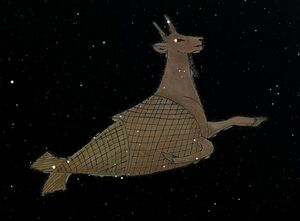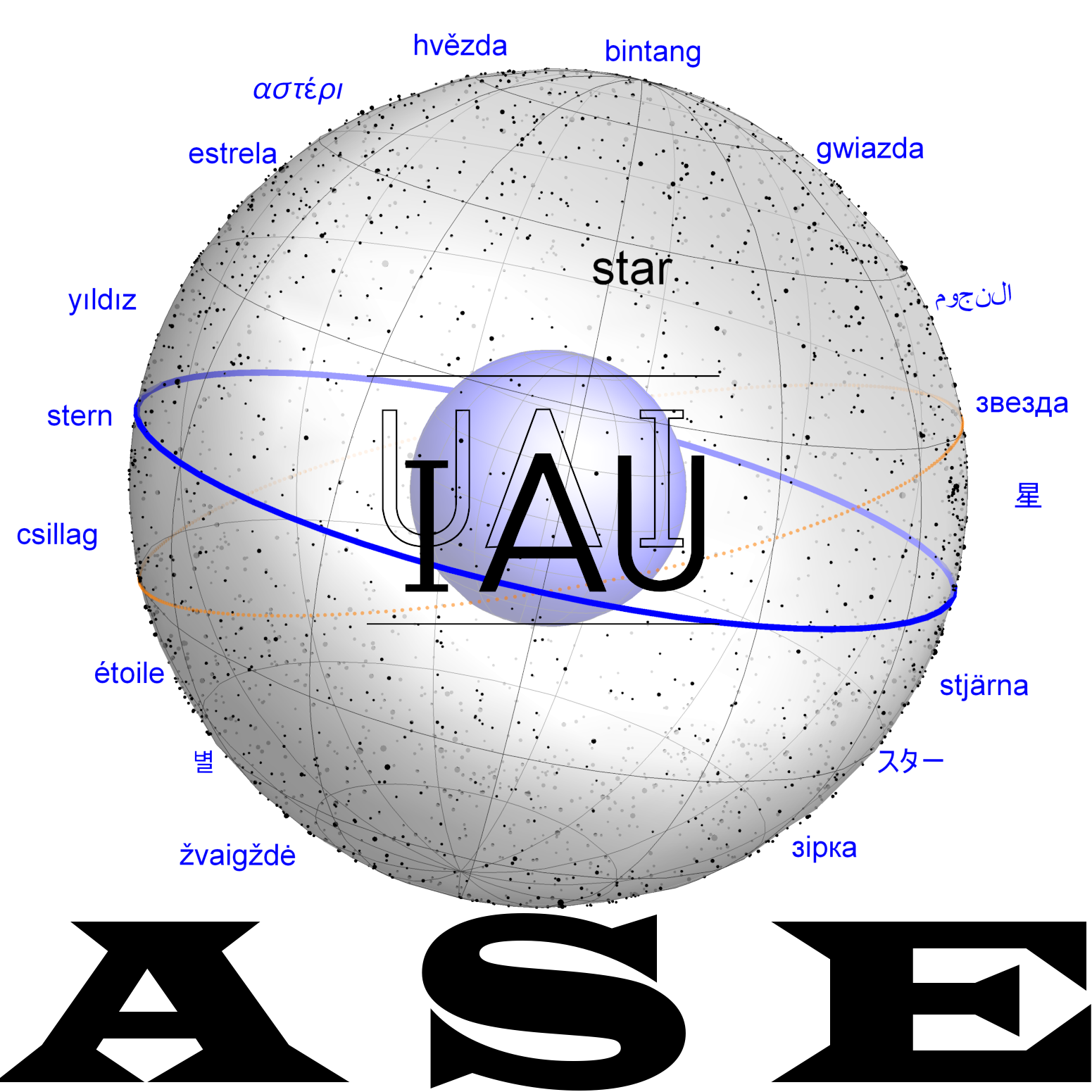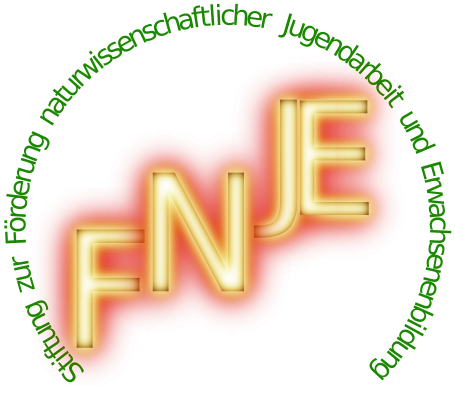Gizzānītu: Difference between revisions
No edit summary |
No edit summary |
||
| (9 intermediate revisions by 3 users not shown) | |||
| Line 1: | Line 1: | ||
{{DISPLAYTITLE:''Gizzānītu''}} |
{{DISPLAYTITLE:''Gizzānītu''}} |
||
[[File:Cap Bab stellarium J-Gullberg.jpg|thumb|Babylonian Goat-Fish in Capricornus (painted by J. Gullberg 2021 for Stellarium).]] |
|||
''Gizzānītu'' is an ancient Mesopotamian asterism in the constellation of [[Capricornus]]. |
|||
''Gizzānītu'' (𒄀𒄑𒍝𒉌𒌈) is a by-name for [[SUḪUR.MAŠ2|SUḪUR.MAŠ<sub>2</sub> <sup>ku<sub>6</sub></sup>]] (Capricorn) that occurs in a calendrical mystical-mythological work in connection with the 'Marduk battle against Tiamat' tradition of Enuma Elish. For the latest edition see Reynolds 2019: 206-207 (see below) with commentary on ibid 31, 362, 366-367. See also Buššānītu. |
|||
==Concordance, Etymology, History<ref>[[Mesopotamian (All Terms)|Planetarium Babylonicum 2.0]], All Skies Encyclopaedia.</ref>== |
|||
==Dictionary== |
|||
===Kurtik with Hilder, Hoffmann, Horowitz, Kim=== |
|||
"Enraged Goat"(?) [Reynolds 1999]; the name of a celestial region (apparently identified apparently with sections of the Goat-Fish constellation) in the Babylonian calendar text BM 55466+ (duplicate BM 35188+), in which an astral interpretation of the battle between Marduk and Tiamat with Kingu, described in the poem Enuma elish, is given for the month of Tebet. |
"Enraged Goat"(?) [Reynolds 1999]; the name of a celestial region (apparently identified apparently with sections of the Goat-Fish constellation) in the Babylonian calendar text BM 55466+ (duplicate BM 35188+), in which an astral interpretation of the battle between Marduk and Tiamat with Kingu, described in the poem Enuma elish, is given for the month of Tebet. |
||
{| class="wikitable" |
{| class="wikitable" |
||
| Line 9: | Line 9: | ||
!Sources!!Identifications |
!Sources!!Identifications |
||
|- |
|- |
||
|'''BM 55466 (Reynolds 2019: 206-207)'''Lines 206: 3-12 to be inserted here |
|||
|'''BM 55466.''' |
|||
translation on p. 207 |
|||
* gi-iz-za-ni-tu<sub>4</sub> u |
* <s>''gi-iz-za-ni-tu''<sub>4</sub> ''u bu-uš-ša''<sub>2</sub>''-ni-tu''<sub>4</sub> ''ša''<sub>2</sub> ''it-ti lib''<sub>3</sub>''-bi'' mul<sub>2</sub>.meš ''qabû''(E)ú / ''ana muḫ-ḫi'' <sup>mul</sup>''enzi''(uz<sub>3</sub>) ''u'' <sup>múl</sup>''pagri''(adda) ''ina lib''<sub>3</sub>-''bi'' <sup>múl</sup>''suḫurmāši''(maš<sub>2</sub>) ''qabi''(dug<sub>4</sub>)bi ''ti-amat u'' <sup>d</sup>''qin-gu'' / ''šu-nu'': ''gi-iz-za-ni-tu''<sub>2</sub>: ''ki-iz za-ni-tu''<sub>2</sub> ''šum''<sub>3</sub>-''šu''<sub>2</sub></s> |
||
* "Gizzanitu and Pushshanitu, which (are numbered) among the stars; so they say, implying the (constellation) Goat and (constellation) Deadman within (the constellation) Goat-Fish. This is Tiamat and Kingu. His name is Gizzanitu, (which means) Enraged Goat." [STC II, Pl. LXX:8-10; Reynolds 1999, 370-371]. |
** <s>"Gizzanitu and Pushshanitu, which (are numbered) among the stars; so they say, implying the (constellation) Goat and (constellation) Deadman within (the constellation) Goat-Fish. This is Tiamat and Kingu. His name is Gizzanitu, (which means) Enraged Goat." [STC II, Pl. LXX:8-10; Reynolds 1999, 370-371].</s> |
||
|Example |
|Example |
||
|} |
|} |
||
===Additional=== |
===Additional=== |
||
The word gi-iz-za-ni-tu<sub>4</sub>/tu<sub>2</sub> is present only in this text and probably represents the singular feminine gender from the root g/k |
The word ''gi-iz-za-ni-tu''<sub>4</sub>/''tu''<sub>2</sub> is present only in this text and probably represents the singular feminine gender from the root g/k-z-z "to shear," the same root corresponds to k/gizzu "goat." [AHw, 496b; CAD G, 115]; the etymology ''gizzānītu'' = ''ki-iz za-ni-tu''<sub>2</sub> "enraged Goat" suggested in the text is mistaken [Reynolds 1999, 376]. |
||
==Historical Dictionaries== |
==Historical Dictionaries== |
||
| Line 39: | Line 40: | ||
[[Category:Eurasia]] |
[[Category:Eurasia]] |
||
[[Category:Cuneiform]] |
[[Category:Cuneiform]] |
||
[[Category:Asterism]] |
|||
[[Category:Cap]] |
|||
Latest revision as of 14:44, 22 December 2025
Gizzānītu (𒄀𒄑𒍝𒉌𒌈) is a by-name for SUḪUR.MAŠ2 ku6 (Capricorn) that occurs in a calendrical mystical-mythological work in connection with the 'Marduk battle against Tiamat' tradition of Enuma Elish. For the latest edition see Reynolds 2019: 206-207 (see below) with commentary on ibid 31, 362, 366-367. See also Buššānītu.
Concordance, Etymology, History[1]
"Enraged Goat"(?) [Reynolds 1999]; the name of a celestial region (apparently identified apparently with sections of the Goat-Fish constellation) in the Babylonian calendar text BM 55466+ (duplicate BM 35188+), in which an astral interpretation of the battle between Marduk and Tiamat with Kingu, described in the poem Enuma elish, is given for the month of Tebet.
| Sources | Identifications |
|---|---|
| BM 55466 (Reynolds 2019: 206-207)Lines 206: 3-12 to be inserted here
translation on p. 207
|
Example |
Additional
The word gi-iz-za-ni-tu4/tu2 is present only in this text and probably represents the singular feminine gender from the root g/k-z-z "to shear," the same root corresponds to k/gizzu "goat." [AHw, 496b; CAD G, 115]; the etymology gizzānītu = ki-iz za-ni-tu2 "enraged Goat" suggested in the text is mistaken [Reynolds 1999, 376].
Historical Dictionaries
| Kurtik (2022, g24) | Gössmann (1950) |
|---|---|
| «Разгневанная Коза»(?) [Reynolds 1999]; название небесной области (отождествляемой, по-видимому с частью созвездия «Коза-Рыба») в вавилонском календарном тексте BM 55466+ (дубликат BM 35188+), в котором для месяца тебету приводится астральная интерпретация сражения между Мардуком и Тиамат с Кингу, описанного в поэме «Энума элиш».
I. Источники. BM 55466. gi-iz-za-ni-tu4 u pu-uš-ša2-ni-tu4 ša2 it-ti lib3-bi mul2.meš qabû(E)ú / ana muḫ-ḫi mulenzi(uz3) u múlpagri(adda) ina lib3-bi múlsuḫurmāši(maš2) qabi(dug4)bi ti-amat u dqin-gu / šu-nu : gi-iz-za-ni-tu2 : ki-iz za-ni-tu2 šum3-šu2 «Гиззаниту и Пушшаниту, которые (числятся) среди звезд; так говорят, подразумевая (созвездие) Козу и (созвездие) Мертвеца внутри (созвездия) Коза-Рыба. Это — Тиамат и Кингу. Его имя Гиззаниту, (что означает) Разгневанная Коза» [STC II, Pl. LXX:8–10; Reynolds 1999, 370–371]. Слово gi-iz-za-ni-tu4/tu2 присутствует только в этом тексте и, возможно, представляет единственное чиcло женского рода от корня g/k z z «стричь», этот же корень соответствует k/gizzu «козел» [AHw, 496b; CAD G, 115]; предложенная в тексте этимология gizzānītu = ki-iz za-ni-tu2 «Разгневанная Коза», ошибочна [Reynolds 1999, 376]. |
Example |
References
- ↑ Planetarium Babylonicum 2.0, All Skies Encyclopaedia.





